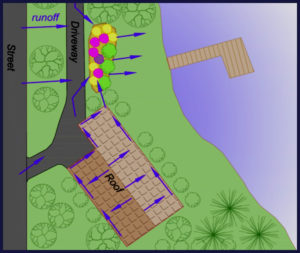What is Bioretention?
Rain gardens and Bioretentions are Stormwater Best Management Practices (BMPs) that utilize plants to filter sediment and treat runoff. Each stormwater BMP uses specific design criteria to manage runoff from the surrounding land.
The term “Rain Gardens” and “Bioretention” are sometimes used interchangeably. A Bioretention is designed for larger runoff areas and often utilize layers of filter media and gravel for added water storage; cleanout pipes and underdrains; and engineered overflow outlets. Rain Gardens are much simpler, usually created as a landscape depression with runoff directed from smaller catchment areas (e.g. residential sites). Stormwater BMPs installed in urban and residential areas throughout the watershed help protect our waterways from nutrient and sediment pollution.
FACT: Stormwater pollution is the #1 source of water pollution in the United States.
https://www.epa.gov/nps/basic-information-about-nonpoint-source-nps-pollution

Benefits of Bioretention
Bioretention combines physical and biological components to capture and treat stormwater before it reaches surface waters and the Chesapeake Bay.
Stormwater Runoff Reduction Benefits
- Capturing and holding stormwater to allow time for pollutants to settle out
- Increasing infiltration to groundwater
- Reducing flash flooding
- Reducing erosion of stream channels by slowing the velocity of water entering natural streams
Biological and Habitat Benefits
- Living plants take up excess nutrients such as Phosphorus and Nitrogen from fertilizers and animal waste runoff
- The soil media in a Bioretention facility acts as a sponge, holding on to pollutants and filtering sediments
- Microbes living in soil can actually volatize pollutants, such as hydrocarbons, rendering them harmnless
- Living plants provide habitat for wildlife